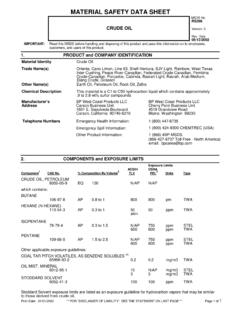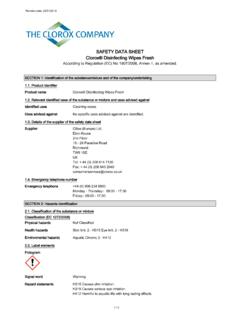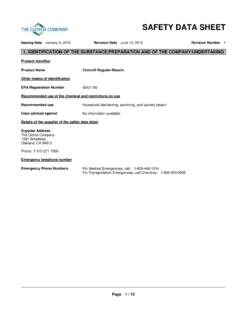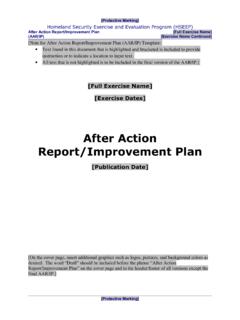Transcription of MATERIAL SAFETY DATA SHEET
1 MATERIAL SAFETY DATA SHEET . MSDS No. RS296. CRUDE OIL Version: 5. Rev. Date 05/13/2002. IMPORTANT: Read this MSDS before handling and disposing of this product and pass this information on to employees, customers, and users of this product. 1. PRODUCT and COMPANY IDENTIFICATION. MATERIAL Identity Crude Oil Trade Name(s) Oriente, Cano Limon, Line 63, Shell-Ventura, SJV Light, Rainbow, West Texas Inter-Cushing, Peace River-Canadian, Federated Crude-Canadian, Pembina Crude-Canadian, Forcados, Cabinda, Basrah Light, Basrah, Arab Medium, Elang Crude, Girassol Other Name(s) Earth Oil, Petroleum Oil, Rock Oil, Zafiro Chemical Description This MATERIAL is a C1 to C50 hydrocarbon liquid which contains approximately .9 to wt% sulfur compounds Manufacturer's BP West Coast Products LLC BP West Coast Products LLC. Address Carson Business Unit Cherry Point Business Unit 1801 E. Sepulveda Boulevard 4519 Grandview Road Carson, California 90749-6210 Blaine, Washington 98230.
2 Telephone Numbers Emergency Health Information: 1 (800) 447-8735. Emergency Spill Information: 1 (800) 424-9300 CHEMTREC (USA). Other Product Information: 1 (866) 4BP-MSDS. (866-427-6737 Toll Free - North America). email: 2. COMPONENTS and EXPOSURE LIMITS. Exposure Limits ACGIH OSHA. 1 `CAS No. 2 3. Component % Composition By Volume TLV PEL Units Type CRUDE OIL, PETROLEUM. 8002-05-9 EQ 100 N/AP N/AP. which contains: BUTANE. 106-97-8 AP to 1 800 800 pm TWA. HEXANE (N-HEXANE). 110-54-3 AP to 1 50 50 ppm TWA. skin ISOPENTANE. 78-78-4 AP to N/AP 750 ppm STEL. 600 600 ppm TWA. PENTANE. 109-66-0 AP to N/AP 750 ppm STEL. 600 600 ppm TWA. Other applicable exposure guidelines: (4). COAL TAR PITCH VOLATILES, AS BENZENE SOLUBLES. 65996-93-2 mg/m3 TWA. OIL MIST, MINERAL. 8012-95-1 10 N/AP mg/m3 STEL. 5 5 mg/m3 TWA. STODDARD SOLVENT. 8052-41-3 100 100 ppm TWA. Stoddard Solvent exposure limits are listed as an exposure guideline for hydrocarbon vapors that may be similar to those derived from crude oil.
3 Print Date: 01/01/2002 **FOR DISCLAIMER OF LIABILITY , SEE THE STATEMENT ON LAST PAGE** Page 1 of 7. CRUDE OIL MSDS No. RS296. Since specific exposure standards or control limits have not been established for this MATERIAL , the exposure limits shown here are suggested as minimum control guidelines. 1 (1) (2) (3) (4). Carcinogen displayed after Component Name. Listed by NTP, IARC, OSHA, Other 2. See Abbreviations on last page 3. The OSHA exposure limits were changed in 1993 due to a federal court ruling. ARCO has chosen to list the 1989 OSHA exposure limits in this document as they are generally more stringent and therefore more protective than the current exposure limits. (Refer to 29 CFR ). 3. HAZARD IDENTIFICATION. IMMEDIATE HAZARDS. DANGER. HIGHLY FLAMMABLE! OSHA/NFPA Class 1B flammable liquid. KEEP AWAY FROM HEAT, SPARKS, AND. OPEN FLAME! CONTAINS PETROLEUM DISTILLATES!
4 Avoid breathing vapors or mists. Use only with adequate ventilation. If swallowed, do not induce vomiting since aspiration into the lungs may cause chemical pneumonia. Obtain prompt medical attention. May cause irritation or more serious skin disorders! May be harmful if inhaled! May cause irritation of the nose, throat, and lungs, headache, dizziness, drowsiness, loss of coordination, fatigue, nausea and labored breathing. May cause irregular heartbeats. Avoid prolonged or repeated liquid, mist, and vapor contact with eyes, skin, and respiratory tract. Wash hands thoroughly after handling. Sulfur compounds in this MATERIAL may decompose to release hydrogen sulfide gas which may accumulate to potentially lethal concentrations in enclosed air spaces. Vapor concentrations of hydrogen sulfide above 50 ppm, or prolonged exposure at lower concentrations, may saturate human odor perceptions so that the smell of gas may not be apparent.
5 DO NOT DEPEND ON THE SENSE OF SMELL TO DETECT HYDROGEN SULFIDE! Long-term tests show that similar crude oils have produced skin tumors on laboratory animals. Crude oils contain some polycyclic aromatic hydrocarbons which have been shown to be carcinogenic after prolonged or repeated skin contact in laboratory animals. Routes of Exposure Signs and Symptoms Inhalation Vapors or mists from this MATERIAL , at concentrations greater than the recommended (Primary) exposure limits in Section 2, can cause irritation of the nose, throat, and lungs, headache, dizziness, drowsiness, loss of coordination, fatigue, nausea and labored breathing. Airborne concentrations above the recommended exposure limits are not anticipated during normal workplace activities due to the slow evaporation of this MATERIAL at ambient temperatures. Exposure to moderate airborne concentrations of hydrogen sulfide (less than 50 ppm) can result in irritation of the eyes, nose and throat, headache, dizziness, shortness of breath, nausea and nervousness.
6 Exposure to hydrogen sulfide vapor above 200 ppm may cause irritation of mucous membranes, inflammation of the lungs, accumulation of fluid in the lungs, irregular heartbeats, unconsciousness with convulsions or impaired breathing with suffocation. Exposure to higher concentrations of hydrogen sulfide vapor (above 500 ppm). may cause rapid death. Eye Contact May cause slight eye irritation. Skin Contact Moderate skin irritation may occur upon short-term exposure. Exposure to sunlight may increase the degree of skin irritation. Absorption through the skin may occur and produce toxic effects (see Summary of Chronic Hazards). Ingestion May cause irritation of the mouth, throat and gastrointestinal tract leading to nausea, vomiting, diarrhea, and restlessness. May cause headache, dizziness, drowsiness, loss of coordination, fatigue, nausea and labored breathing. ASPIRATION HAZARD: Aspiration into the lungs may cause chemical pneumonia.
7 This MATERIAL can enter the lungs during swallowing or vomiting and may cause lung inflammation and damage which in severe cases may be fatal. Print Date: 01/01/2002 Page 2 of 7. CRUDE OIL MSDS No. RS296. Summary of Personnel with preexisting central nervous system (CNS) disease, skin disorders, or chronic Chronic Hazards respiratory diseases should be evaluated by an appropriate health professional before and Special exposure to this MATERIAL . Health Effects prolonged /repeated skin exposure, inhalation or ingestion of this MATERIAL may result in adverse dermal or systemic effects. Avoid prolonged or repeated exposure. May be harmful if absorbed through the skin. prolonged or repeated contact may create cancer risk, organ damage, and adversely affect reproduction, fetal development and fetal survival. Avoid all skin contact. Neurotoxic effects have been associated with n-hexane, a component of this MATERIAL .
8 Avoid prolonged or repeated exposure. See Section 11 for Additional Toxicological Information. 4. EMERGENCY and FIRST AID. Inhalation Immediately remove personnel to area of fresh air. For respiratory distress, give oxygen, rescue breathing, or administer CPR (cardiopulmonary resuscitation) if necessary. Obtain prompt medical attention. Eye Contact Flush eyes with clean, low-pressure water for at least 15 minutes, occasionally lifting the eyelids. If pain or redness persists after flushing, obtain medical attention. Skin Contact Immediately remove contaminated clothing. Wash affected skin thoroughly with soap and water. If irritation persists, obtain medical attention. Ingestion Do not induce vomiting since aspiration into the lungs may cause lipoid pneumonia. Obtain prompt medical attention. Emergency See above procedures. Personnel with pre-existing central nervous system disease, skin Medical disorders, chronic respiratory diseases, or impaired liver of kidney function should avoid Treatment exposure to this product.
9 Procedures 5. FIRE and EXPLOSION. Flash Point (Method)* Based on NFPA Petroleum, Crude AP 20 F to 90 F NFPA Hazard Rating: Autoignition Temperature (Method)* N/DA Health: 2 = Moderate Flammable Limits (% Vol. in Air* Lower AP 1 ++ Fire: 3 = High Upper AP 8 Reactivity: 0 = Insignificant +. * At Normal Atmospheric Temperature and Pressure Based on NFPA 325 Special: Fire and HIGHLY FLAMMABLE! This MATERIAL releases flammable vapors at or below ambient Explosion temperatures. When mixed with air in certain proportions and exposed to an ignition source, Hazards these vapors can burn in the open or explode in confined spaces. Flammable vapors may travel long distances along the ground before reaching a point of ignition and flashing back. Open top tanks involved in a fire have a potential for "boil-over" if water or water-in-oil emulsion is at the bottom of the tank. Boil-over may result in a large expulsion of burning oil from the tank, greatly increasing the fire area.)
10 Extinguishing Foam, Dry chemical, Carbon dioxide (CO2). Media Water and water fog can cool the fire but may not extinguish the fire. Special For fires involving this MATERIAL , do not enter any enclosed or confined fire space without Firefighting proper protective equipment. This may include self-contained breathing apparatus to protect Procedures against the hazardous effects of combustion products and oxygen deficiencies. Cool tanks and containers exposed to fire with water. If firefighters cannot work upwind to the fire, respiratory protective equipment must be worn unless and until atmospheric monitoring indicates that such protection is not required. Improper use of water and extinguishing media containing water may cause frothing which can spread the fire over a larger area. Water fog or spray are of value for cooling tank shells and surfaces exposed to fire, but may not achieve extinguishment.







